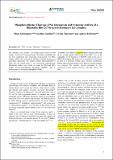Phosphate diester cleavage, DNA interaction and cytotoxic Activity of a bimetallic bis(1,4,7-triazacyclononane) zinc complex

View/
Date
2014-06-24Author
Montagner, Diego
Gandin, Valentina
Marzano, Cristina
Erxleben, Andrea
Metadata
Show full item recordUsage
This item's downloads: 365 (view details)
Cited 13 times in Scopus (view citations)
Recommended Citation
Montagner, D., Gandin, V., Marzano, C. and Erxleben, A. (2014), Phosphate Diester Cleavage, DNA Interaction and Cytotoxic Activity of a Bimetallic Bis(1,4,7-triazacyclononane) Zinc Complex. Eur. J. Inorg. Chem., 2014: 4084–4092. doi:10.1002/ejic.201402319
Published Version
Abstract
The dinuclear zinc complex [Zn-2{bcmp(-H)}(mu-Cl)](ClO4)(2)center dot H2O {bcmp = 2,6-bis(1,4,7-triazacyclonon-1-ylmethyl)-4-methylphenol} has been synthesized and structurally characterized. The DNA binding affinity was assessed by ethidium bromide fluorescence quenching experiments. The complex relaxes supercoiled pUC19 DNA into the nicked form at low micromolar concentration. Mechanistic studies were carried out using the DNA and RNA models bis(2,4-dinitrophenyl) phosphate (BDNPP) and 2-hydroxypropyl p-nitrophenyl phosphate (HPNP). A detailed kinetic analysis suggested that the bridging OH group of the solution species [Zn-2{bcmp(-H)}(mu-OH)](2+) acts as the nucleophile in the hydrolysis of BDNPP, while in the case of HPNP, the bridging OH group acts as a general base and seems to shift to a terminal position upon substrate coordination. Finally, the cytotoxicity profile of the dinuclear zinc(II) complex was assessed. The complex showed promising in vitro antitumour activity against pancreatic and lung cancers cell lines.

